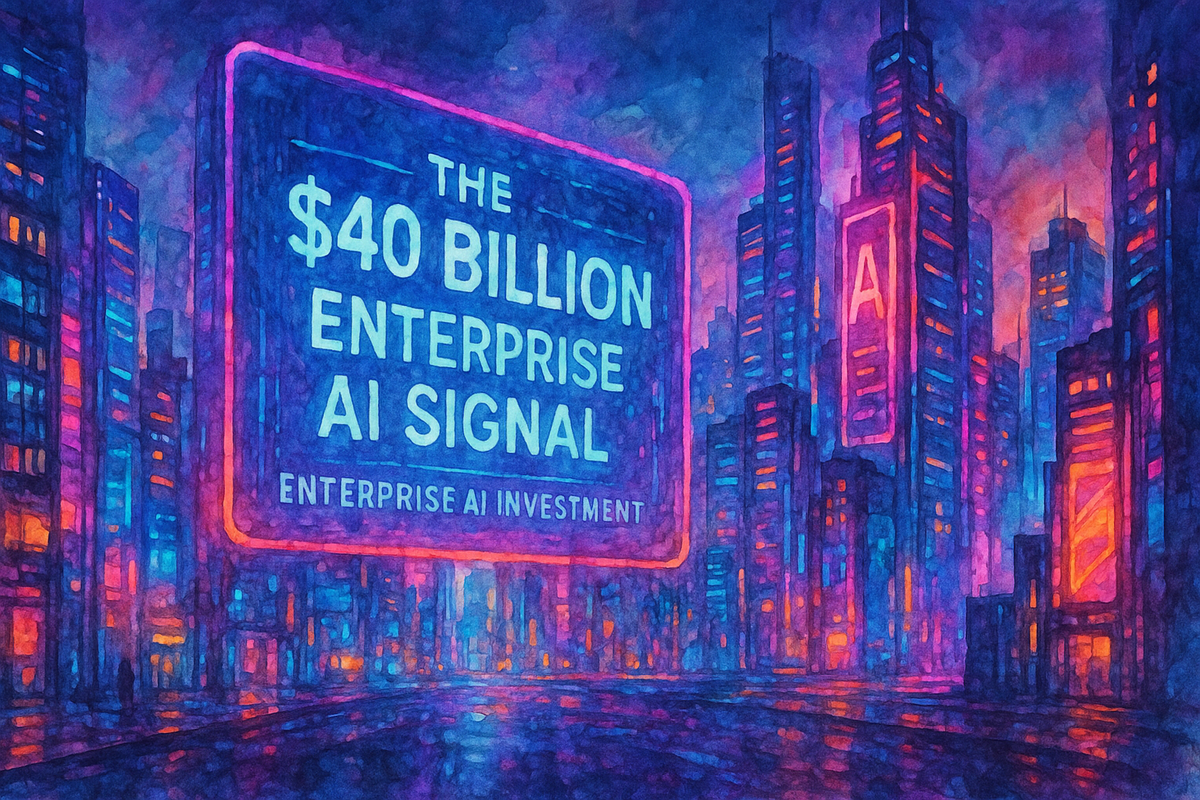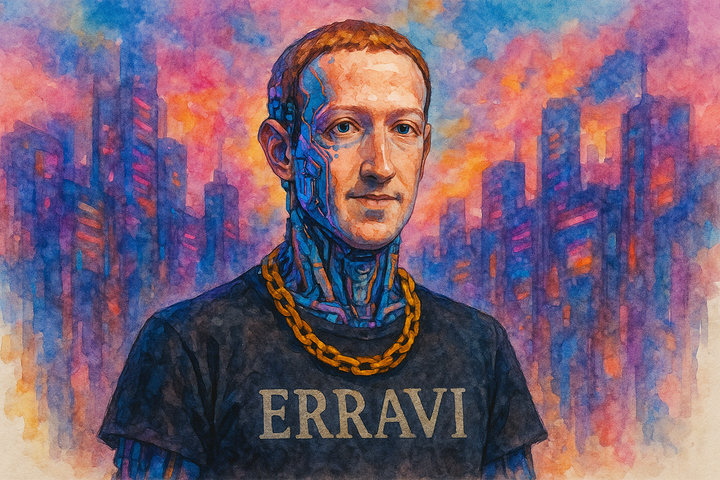The $40 Billion Enterprise AI Signal: What OpenAI's Record Funding Means for Your Transformation Strategy
OpenAI's $40B funding validates AI transformation as competitive necessity. With $644B in global AI spending expected this year, organizations have 18 months to move from pilots to systematic implementation or risk displacement.

If you've been waiting for validation that AI transformation is becoming competitive necessity, not optional enhancement, you just got it. OpenAI's record $40 billion funding round isn't just Silicon Valley news—it's a market signal that changes everything for enterprise strategy.
Key Takeaway: OpenAI's record $40 billion funding round validates that enterprise AI transformation is entering its acceleration phase. For business leaders, this signals three critical insights: (1) AI implementation is becoming competitive necessity, not optional enhancement, (2) Human-first transformation strategies are attracting major investment validation, and (3) Organizations must move beyond pilot projects to systematic implementation within 18 months or risk competitive displacement.
This represents the largest private funding round in tech industry history, positioning OpenAI with a $300 billion post-money valuation behind only SpaceX. But here's what most enterprise leaders are missing: this isn't about one company getting rich. It's about the fundamental economics of business changing faster than most organizations realize.
What Does This Market Signal Mean for Enterprise Investment Strategy?
The investment timeline has accelerated dramatically from market analysis perspective. OpenAI now has 500 million weekly active users and CEO Sam Altman reported they "added one million users in the last hour" during a viral image generation feature launch, driving enterprise demand that most organizations aren't prepared to meet. Companies are expected to spend $644 billion on generative AI this year—a 76.4% increase from 2024, according to Gartner.
But there's a critical deadline embedded in this funding: SoftBank's investment could be slashed to as low as $20 billion if OpenAI doesn't restructure into a for-profit entity by December 31. This isn't just OpenAI's timeline pressure—it signals that investors expect rapid organizational transformation across the AI landscape.
Here's what this means for your planning: the 18-month window I've been discussing for systematic AI implementation just got shorter. Organizations still running pilot projects while waiting for "clarity" are about to face competitive displacement from companies that moved decisively.
This validates our analysis that we're at an AI inflection point where the next 18 months will determine competitive positioning for the decade ahead.
How Should Enterprise Leaders Interpret This Investment Wave?
This isn't just another funding round—it's market validation of a fundamental business model shift. The best performing AI companies now achieve ARR per employee greater than $1 million, outperforming traditional "great" companies by more than 3x. Some AI-native startups are reaching $100M ARR with fewer than 100 employees, compared to the 500+ employees traditionally required.
The market economics are staggering: OpenAI generated $3.7 billion in revenue in 2024 with approximately 500-624 employees, demonstrating the efficiency gains that institutional investors are betting on. When venture capital sees companies achieving 15-25x efficiency improvements through AI-native operations compared to conventional business models, they don't hesitate to deploy capital at unprecedented scale.
This transformation mirrors the patterns we've identified in the hybrid workforce revolution where leading organizations are redefining operational models through human-AI collaboration.
Why Are Smart Investors Betting on Human-AI Collaboration?
The research reveals why sophisticated investors like SoftBank are betting on human-AI collaboration rather than replacement strategies. While 74% of companies struggle to achieve value from AI, leaders who focus on people and processes—allocating 70% of resources to human elements versus just 10% to algorithms—achieve more than twice the ROI.
Particularly telling: cybersecurity initiatives show the strongest results, with 44% exceeding ROI expectations. This validates the human-AI partnership approach where technology augments rather than replaces human expertise in complex decision-making.
McKinsey's 2024 research confirms that the biggest barrier to AI scaling isn't employees—who are ready—but leaders who aren't steering fast enough. In fact, 71% of employees trust their employers more than universities or tech companies to deploy AI responsibly. Organizations that understand this dynamic are attracting the smart money.
This validates what I've been documenting through Harvard Business Review's digital teammates research. The companies that survived the early AI adoption wave learned that augmentation, not replacement, creates sustainable competitive advantage.
"Smart money recognizes that leaders who allocate 70% of AI resources to people and processes achieve more than twice the ROI of those focused primarily on technology."
What ROI Can Enterprises Expect from AI Investment?
The ROI data validates OpenAI's massive funding round. Almost all organizations with advanced AI initiatives report measurable ROI, with 20% reporting ROI in excess of 30%. More tellingly, companies implementing AI intrinsically achieve 20% to 30% gains in productivity, speed to market, and revenue—compounding across business areas until transformation is complete.
Microsoft's IDC study reveals that for every $1 invested in generative AI, companies see $3.7x ROI, with top performers achieving $10.3x returns. Enterprise spending on generative AI applications jumped to $4.6 billion in 2024—an 8x increase from $600 million the previous year.
Yet here's the reality check: organizations acknowledge they need at least 12 months to resolve scaling challenges around governance, training, and trust. Only 1% of executives describe their AI rollouts as "mature," meaning AI is fully integrated into workflows and drives substantial business outcomes.
This connects directly to the framework I established in my Microsoft 365 AI guide. Organizations that approach AI transformation systematically—with proper platform integration and human-first design—consistently outperform those treating it as point solutions.
The pattern mirrors what I documented in Duolingo's AI-first disaster: replacement strategies fail while collaboration approaches succeed.
The Bottom Line: Your Next 18 Months Just Became Critical
OpenAI's $40 billion funding round isn't just about one company getting rich. It validates three fundamental shifts that will determine competitive positioning for the next decade:
AI Implementation Is Now Competitive Necessity
Companies are expected to spend $644 billion on generative AI this year, with OpenAI adding one million users per hour during peak viral moments. Organizations still running pilot projects while waiting for "clarity" face competitive displacement.
Human-First Transformation Wins
Smart money recognizes that leaders who allocate 70% of AI resources to people and processes achieve more than twice the ROI of those focused primarily on technology. This validates the approach of building human-agent teamsrather than pursuing replacement strategies.
Platform Integration Delivers Scale
$18 billion of OpenAI's funding targets the Stargate infrastructure project, enabling enterprise-scale deployments that individual organizations can't match independently.
"The question isn't whether AI transformation will happen—it's whether you'll lead it or be disrupted by it."
The organizations wondering if they're at an AI inflection point just got their answer. The market has moved beyond readiness to execution.
This validates Microsoft's Frontier Firm research showing that organizations with systematic AI approaches achieve 71% vs 37% thriving rates compared to traditional firms. Organizations ready to take action can follow our practical roadmap for building your own Frontier Firm.
The pattern connects to what I've documented about the 55% AI implementation regret rate among organizations that rushed into AI-first approaches without strategic planning. This funding validates the opposite approach: human-centered transformation with systematic implementation.
This isn't the time to wait for "better" AI tools or more "clarity" about implementation. This is the time to move systematically toward human-agent teams that define tomorrow's competitive landscape.
Your competitors who understand this dynamic are already securing their position. The hybrid workforce revolution is accelerating, and market leaders are establishing their advantage now.
This transformation isn't simple, and you don't have to figure it out alone. If you're ready to move beyond pilot projects toward systematic AI implementation that delivers measurable ROI, I help organizations navigate exactly this challenge.
Subscribe to my newsletter so you don't miss insights that could transform your approach to AI adoption. Share this analysis with someone who's wrestling with similar strategic decisions—your perspective in the comments could help others navigate this complexity.
Consider sharing this with your LinkedIn network. The executives in your professional circle are facing these same strategic decisions, and your insights could spark valuable discussions about how to approach AI transformation systematically.
Ready to develop your organization's human-first AI transformation strategy? Let's discuss how to position your company among the leaders who are capturing value while their competitors struggle with implementation.




Comments ()